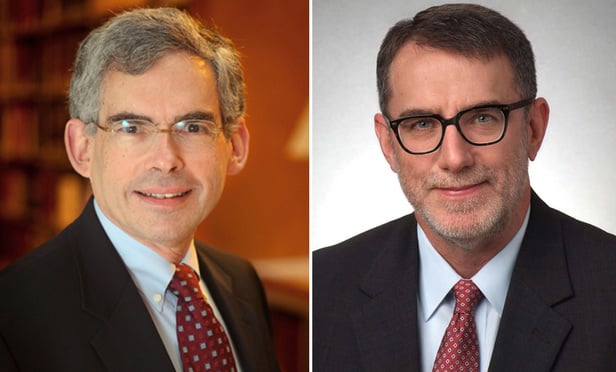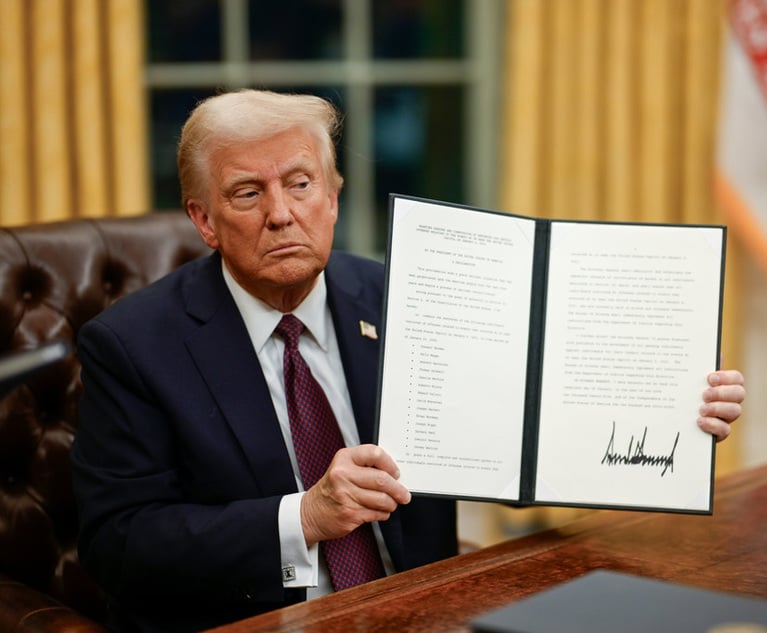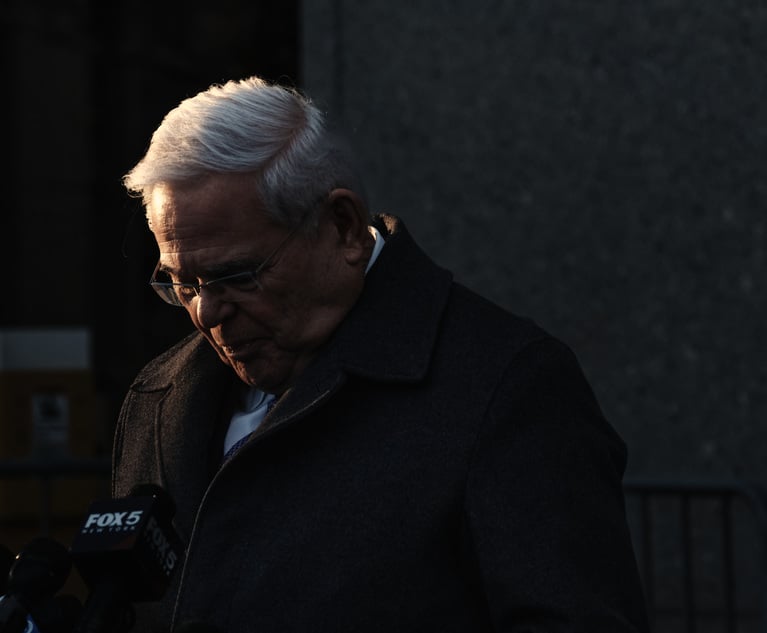Recent Developments Concerning Agency Guidance Documents
Over the past several months both the Trump administration and courts in New York have attempted to strike a balance between the tendency of agencies to use guidance to expand their authority without the protections associated with notice and comment rulemaking. In their Environmental Law column Michael Gerrard and Edward McTiernan explore these recent developments and what they might mean as for the EPA and DEC.
November 06, 2019 at 12:30 PM
8 minute read
 Michael B. Gerrard and Edward McTiernan
Michael B. Gerrard and Edward McTiernan
Administrative agencies occasionally find it useful to communicate with the regulated community or other stakeholders without devoting time and finite resources to rulemaking. Federal and state agencies charged with protecting human health and the environment seem to be especially reliant on guidance in the form of interpretative rules, technical memoranda and advisory opinions. Such guidance can help effectively communicate an agency's views on ambiguous or conflicting statutory provisions or judicial decisions to the regulated community, and to counsel and technical consultants on all sides of an issue. Agencies called upon to regulate emerging industries or issues can use guidance to provide direction without locking themselves into final positions while experts debate the available facts.
In addition, well-crafted guidance documents can aid agency staff in the consistent interpretation and application of complex and cumbersome regulations. Such consistency can be especially helpful to a regulated entity when dealing with agencies like the U.S. Environmental Protection Agency (EPA) or the New York State Department of Environmental Conservation (DEC), which rely upon decentralized decision-makers.
However, guidance is not subject to formal public notice and comment. When agencies move beyond explaining existing rules and rely on guidance as a substitute for rulemaking they can run afoul of the notice requirements in the Administrative Procedure Act (APA), 5 U.S.C. §§551-559, and its New York counterpart, the State Administrative Procedure Act (SAPA), as well as the New York State Constitution's requirement that all rules be filed with the New York Department of State before taking effect. N.Y. Const. art. IV, §8.
Moreover, when guidance on the federal or state level controls agency action and enforcement decisions, it amounts to illegal rulemaking. Over the past several months both the Trump administration and courts in New York have attempted to strike a balance between the tendency of agencies to use guidance to expand their authority without the protections associated with notice and comment rulemaking and the benefits of informal agency guidance. In this column we explore these developments and what they might mean as a practical matter for EPA and DEC.
Executive Orders
On Oct. 9, 2019, President Trump issued a pair of executive orders intended to change how federal agencies announce and use guidance. Executive Order 13892, titled "Promoting the Rule of Law Through Transparency and Fairness in Civil Administrative Enforcement and Adjudication," 84 Fed. Reg. 55239 (Oct. 15, 2019), is not limited to rulemaking. Nevertheless, §3 reinforces existing law by stating that agencies "may not treat noncompliance with a standard of conduct announced solely in a guidance document as itself a violation" and requires that agencies only make enforcement decisions based upon interpretative guidance that is publicly available and posted on the agency website.
There are also two provisions in this executive order that do not deal directly with guidance but which could especially impact EPA. Section 7 requires agencies to publish rules for conducting inspections by March 1, 2020, and §9 gives agencies 270 days to adopt policies that encourage self-reporting of violations by establishing reductions or waivers of civil penalties. Although EPA published guidance titled "Incentives for Self-Policing: Discovery, Disclosure, Correction and Prevention of Violations" back in 2000 (65 Fed. Reg. 19618 (April 11, 2000)), and announced a "renewed emphasis" on its self-disclosure violation policies as recently as May of last year (Press Release, EPA, EPA Announces Renewed Emphasis on Self-Disclosed Violation Policies (May 15, 2018)), the Transparency and Fairness Order may fuel calls for EPA to provide further incentives for regulated entities to voluntarily discover and fix violations of federal environmental laws and regulations without any penalty.
President Trump's other executive order is titled "Promoting the Rule of Law Through Improved Agency Guidance Documents." Exec. Order No. 13891, 84 Fed. Reg. 55235 (Oct. 15, 2019). Section 4 introduces a new requirement by mandating that all agencies establish procedures enabling interested parties to petition for withdrawal or modification of any guidance document. This order also reprises the concept of special treatment for "significant" guidance. The concept of significant guidance was first advanced by the Office of Management and Budget (OMB) back in 2007. See OMB Bulletin No. 07-02 (Jan. 18, 2007).
Under the Improved Agency Guidance Order, a guidance document is "significant" if it is reasonably expected to have an adverse economic impact of $100 million; create serious inconsistency between actions planned by other agencies; have an impact on entitlements, user fees or loan programs; or raise novel legal or policy issues. Unlike mere guidance, which is traditionally announced without a formal opportunity for public comment, significant guidance documents will, after OMB establishes procedures, require a 30-day public notice-and-comment period. It is reasonable to expect that many of EPA's proposed guidance documents will qualify as significant and that numerous existing EPA interpretative rules, technical memoranda and advisory opinions will be subject to petitions seeking modification or withdrawal. If the Improved Agency Guidance Order gains traction, EPA will likely need to devote substantial staff to defending past guidance.
Moreover, agencies in general, and EPA in particular, may quickly conclude that significant guidance should simply be duly promulgated as rules by following the APA. Of course, EPA might also simply refrain from providing significant guidance, leaving the regulated community to speculate about the Agency's views on many important issues.
It is noteworthy that the President's Improved Agency Guidance Order also adopts an approach already found in §202-e of New York's SAPA requiring the public listing of all guidance documents on which any agency currently relies, not less than once each year. This requirement might come as a surprise to some environmental practitioners in New York because DEC is exempt from this section of SAPA. As a result, when dealing with DEC the regulated community is forced to scour the department's website for guidance and can seldom be certain that they have considered all relevant documents.
State Level
Recent developments concerning use of guidance have not been confined to the federal government. On Aug. 27, 2019, the Albany County Supreme Court invalidated DEC's Household Cleansing Product Information Disclosure Program as a rule which the agency failed to expose to notice and comment in accordance with SAPA. Last year in this publication, we explored the background and major components of this DEC ingredient disclosure program. See Michael B. Gerrard & Edward McTiernan, NY's Expanded Ingredient Disclosure Requirements for Household Cleaning Products, N.Y.L.J., Sept. 13, 2018, at 3.
Shortly thereafter, in October of last year, two trade associations filed a lawsuit claiming that by announcing the cleaning product disclosure program, DEC had adopted a de facto rule in violation of SAPA. In deciding Household & Commercial Products Association v. DEC, 2019 N.Y. Misc. LEXIS 4973 (Sup. Ct. Aug. 27, 2019), the court relied heavily on the seminal 1985 New York decision concerning when agency guidance constitutes a binding rule, Roman Catholic Diocese of Albany v. New York State Department of Health, 66 N.Y.2d 948 (1985), in which the Court of Appeals announced that "a fixed, general principle to be applied by an administrative agency without regard to other facts and circumstances relevant to the regulatory scheme of the statute it administers" must be treated as a rule and undergo SAPA notice-and-comment rulemaking.
The inquiry into whether guidance slips over the line and becomes a fixed general principle that, in essence, dictates the outcome of a particular agency decision is often fact intensive. In Household & Commercial Products Association, the court focused on the absence of an "opt out" option to conclude that DEC's ingredient disclosure program was mandatory and therefore constituted a rule which took effect without complying with SAPA's notice-and-comment requirements.
A similar analysis was used to reach a different conclusion in a long-running dispute concerning DEC's decision to build a bridge to facilitate snowmobiling over a wild and scenic river. Adirondack Wild v. New York State Adirondack Park Agency, 75 N.Y.S.3d 681 (App. Div. 2018), aff'd on other grounds, 2019 NY LEXIS 2993 (Oct. 22, 2019), the Third Department concluded that DEC was free to ignore certain publicly announced policies concerning such construction projects because DEC had left itself the option of considering site-specific facts. At this time, if DEC wishes to advance its ingredient disclosure program without SAPA notice and public comment, it will need to follow the approach in Adirondack Wild and develop a meaningful alternative which allows the regulated community to opt out of the prescriptive disclosure provisions that were previously announced.
Conclusion
These recent developments demonstrate how elected officials and courts are continuously attempting to strike a balance between curtailing the use of guidance to expand the authority of administrative agencies and the legitimate use of informal guidance documents to engage the public and regulated community on complex technical or policy issues. Recent pronouncements by the president and decisions by courts in New York confirm that EPA and DEC can expect to find themselves at the center of this balancing act.
Michael B. Gerrard is a professor and Director of the Sabin Center for Climate Change Law at Columbia Law School, and Senior Counsel to Arnold & Porter. Edward McTiernan is a partner with Arnold & Porter, and former General Counsel of the New York State Department of Environmental Conservation.
This content has been archived. It is available through our partners, LexisNexis® and Bloomberg Law.
To view this content, please continue to their sites.
Not a Lexis Subscriber?
Subscribe Now
Not a Bloomberg Law Subscriber?
Subscribe Now
NOT FOR REPRINT
© 2025 ALM Global, LLC, All Rights Reserved. Request academic re-use from www.copyright.com. All other uses, submit a request to [email protected]. For more information visit Asset & Logo Licensing.
You Might Like
View All


'You Became a Corrupt Politician': Judge Gives Prison Time to Former Sen. Robert Menendez for Corruption Conviction
5 minute readTrending Stories
- 1Uber Files RICO Suit Against Plaintiff-Side Firms Alleging Fraudulent Injury Claims
- 2The Law Firm Disrupted: Scrutinizing the Elephant More Than the Mouse
- 3Inherent Diminished Value Damages Unavailable to 3rd-Party Claimants, Court Says
- 4Pa. Defense Firm Sued by Client Over Ex-Eagles Player's $43.5M Med Mal Win
- 5Losses Mount at Morris Manning, but Departing Ex-Chair Stays Bullish About His Old Firm's Future
Who Got The Work
J. Brugh Lower of Gibbons has entered an appearance for industrial equipment supplier Devco Corporation in a pending trademark infringement lawsuit. The suit, accusing the defendant of selling knock-off Graco products, was filed Dec. 18 in New Jersey District Court by Rivkin Radler on behalf of Graco Inc. and Graco Minnesota. The case, assigned to U.S. District Judge Zahid N. Quraishi, is 3:24-cv-11294, Graco Inc. et al v. Devco Corporation.
Who Got The Work
Rebecca Maller-Stein and Kent A. Yalowitz of Arnold & Porter Kaye Scholer have entered their appearances for Hanaco Venture Capital and its executives, Lior Prosor and David Frankel, in a pending securities lawsuit. The action, filed on Dec. 24 in New York Southern District Court by Zell, Aron & Co. on behalf of Goldeneye Advisors, accuses the defendants of negligently and fraudulently managing the plaintiff's $1 million investment. The case, assigned to U.S. District Judge Vernon S. Broderick, is 1:24-cv-09918, Goldeneye Advisors, LLC v. Hanaco Venture Capital, Ltd. et al.
Who Got The Work
Attorneys from A&O Shearman has stepped in as defense counsel for Toronto-Dominion Bank and other defendants in a pending securities class action. The suit, filed Dec. 11 in New York Southern District Court by Bleichmar Fonti & Auld, accuses the defendants of concealing the bank's 'pervasive' deficiencies in regards to its compliance with the Bank Secrecy Act and the quality of its anti-money laundering controls. The case, assigned to U.S. District Judge Arun Subramanian, is 1:24-cv-09445, Gonzalez v. The Toronto-Dominion Bank et al.
Who Got The Work
Crown Castle International, a Pennsylvania company providing shared communications infrastructure, has turned to Luke D. Wolf of Gordon Rees Scully Mansukhani to fend off a pending breach-of-contract lawsuit. The court action, filed Nov. 25 in Michigan Eastern District Court by Hooper Hathaway PC on behalf of The Town Residences LLC, accuses Crown Castle of failing to transfer approximately $30,000 in utility payments from T-Mobile in breach of a roof-top lease and assignment agreement. The case, assigned to U.S. District Judge Susan K. Declercq, is 2:24-cv-13131, The Town Residences LLC v. T-Mobile US, Inc. et al.
Who Got The Work
Wilfred P. Coronato and Daniel M. Schwartz of McCarter & English have stepped in as defense counsel to Electrolux Home Products Inc. in a pending product liability lawsuit. The court action, filed Nov. 26 in New York Eastern District Court by Poulos Lopiccolo PC and Nagel Rice LLP on behalf of David Stern, alleges that the defendant's refrigerators’ drawers and shelving repeatedly break and fall apart within months after purchase. The case, assigned to U.S. District Judge Joan M. Azrack, is 2:24-cv-08204, Stern v. Electrolux Home Products, Inc.
Featured Firms
Law Offices of Gary Martin Hays & Associates, P.C.
(470) 294-1674
Law Offices of Mark E. Salomone
(857) 444-6468
Smith & Hassler
(713) 739-1250







